Paleowind Directions over the Tarim Block during the Mesoproterozoic, Northwestern China
Abstract
:1. Introduction
2. Geological Setting
2.1. Tectonic Setting

2.2. Stratigraphy
2.3. Depositional Environments
3. Sampling and Methods
3.1. Field Methods and Sample Collection
3.2. Magnetic Fabric Analysis
4. Results
4.1. Anisotropy of Magnetic Susceptibility for each Cryogenian Series
4.2. Anisotropy of Magnetic Susceptibility for Each Ediacaran Series
5. Discussion
5.1. Reconstruction of Paleowind Directions Quantitatively
5.2. Significance of Paleowind Directions for Paleogeography
6. Conclusions
Supplementary Materials
Author Contributions
Funding
Data Availability Statement
Acknowledgments
Conflicts of Interest
References
- Gladkochub, D.P.; Donskaya, T.V.; Stanevich, A.M.; Pisarevsky, S.A.; Zhang, S.; Motova, Z.L.; Mazukabzov, A.M.; Li, H. U-Pb detrital zircon geochronology and provenance of Neoproterozoic sedimentary rocks in southern Siberia: New insights into breakup of Rodinia and opening of Paleo-Asian Ocean. Gondwana Res. 2019, 65, 1–16. [Google Scholar] [CrossRef]
- Poprawa, P.; Krzemińska, E.; Pacześna, J.; Amstrong, R. Geochronology of the Volyn volcanic complex at the western slope of the East European Craton–Relevance to the Neoproterozoic rifting and the break-up of Rodinia/Pannotia. Precambrian Res. 2020, 346, 105817. [Google Scholar] [CrossRef]
- Kulakov, E.V.; Slagstad, T.; Ganerød, M.; Torsvik, T.H. Paleomagnetism and 40Ar/39Ar geochronology of Meso-Neoproterozoic rocks from southwest Norway. Implications for magnetic remanence ages and the paleogeography of Baltica in a Rodinia supercontinent context. Precambrian Res. 2022, 379, 106786. [Google Scholar] [CrossRef]
- Zhang, F.-Q.; Dilek, Y.; Cheng, X.-G.; Wu, H.-X.; Lin, X.-B.; Chen, H.-L. Late Neoproterozoic–early Paleozoic seismic structure–stratigraphy of the SW Tarim Block (China), its passive margin evolution and the Tarim–Rodinia breakup. Precambrian Res. 2019, 334, 105456. [Google Scholar] [CrossRef]
- Zhao, P.; He, J.; Deng, C.; Chen, Y.; Mitchell, R.N. Early Neoproterozoic (870–820 Ma) amalgamation of the Tarim craton (northwestern China) and the final assembly of Rodinia. Geology 2021, 49, 1277–1282. [Google Scholar] [CrossRef]
- Wu, H.-X.; Zhang, F.-Q.; Dilek, Y.; Chen, H.-L.; Wang, C.-Y.; Lin, X.-B.; Chen, X.-G.; Zhu, K.-Y. Mid–Neoproterozoic collision of the Tarim Craton with the Yili–Central Tianshan Block towards the final assembly of Supercontinent Rodinia: A new model. Earth-Sci. Rev. 2022, 228, 103989. [Google Scholar] [CrossRef]
- He, J.; Xu, B.; Li, D. Newly discovered early Neoproterozoic (ca. 900 Ma) andesitic rocks in the northwestern Tarim Craton: Implications for the reconstruction of the Rodinia supercontinent. Precambrian Res. 2019, 325, 55–68. [Google Scholar] [CrossRef]
- Ren, R.; Guan, S.-W.; Zhang, S.-C.; Wu, L.; Zhang, H.-Y. How did the peripheral subduction drive the Rodinia breakup: Constraints from the Neoproterozoic tectonic process in the northern Tarim Craton. Precambrian Res. 2020, 339, 105612. [Google Scholar] [CrossRef]
- Zhu, G.-Y.; Chen, Z.-Y.; Chen, W.-Y.; Yan, H.-H.; Zhang, P.-H. Revisiting to the Neoproterozoic tectonic evolution of the Tarim Block, NW China. Precambrian Res. 2021, 352, 106013. [Google Scholar] [CrossRef]
- Wood, R.; Liu, A.G.; Bowyer, F.; Wilby, P.R.; Dunn, F.S.; Kenchington, C.G.; Hoyal Cuthill, J.F.; Mitchell, E.G.; Penny, A. Integrated records of environmental change and evolution challenge the Cambrian Explosion. Nat. Ecol. Evol. 2019, 3, 528–538. [Google Scholar]
- Darroch, S.A.; Cribb, A.T.; Buatois, L.A.; Germs, G.J.; Kenchington, C.G.; Smith, E.F.; Mocke, H.; Neil, G.R.; Schiffbauer, J.D.; Maloney, K.M.; et al. The trace fossil record of the Nama Group, Namibia: Exploring the terminal Ediacaran roots of the Cambrian explosion. Earth-Sci. Rev. 2021, 212, 103435. [Google Scholar] [CrossRef]
- Giuliani, A.; Drysdale, R.N.; Woodhead, J.D.; Planavsky, N.J.; Phillips, D.; Hergt, J.; Griffin, W.L.; Oesch, S.; Dalton, H.; Davies, G.R. Perturbation of the deep-Earth carbon cycle in response to the Cambrian Explosion. Sci. Adv. 2022, 8, eabj1325. [Google Scholar] [CrossRef] [PubMed]
- Gallet, Y.; Pavlov, V.; Korovnikov, I. Extreme geomagnetic reversal frequency during the Middle Cambrian as revealed by the magnetostratigraphy of the Khorbusuonka section (northeastern Siberia). Earth Planet. Sci. Lett. 2019, 528, 115823. [Google Scholar] [CrossRef]
- Sergeev, V.N.; Schopf, J.W.; Kudryavtsev, A.B. Global microfossil changes through the Precambrian-Cambrian phosphogenic event: The Shabakta Formation of the phosphorite-bearing Maly Karatau Range, South Kazakhstan. Precambrian Res. 2020, 349, 105386. [Google Scholar] [CrossRef]
- Tatzel, M.; Stuff, M.; Franz, G.; Hippler, D.; Wiechert, U.; von Blanckenburg, F. Siliceous sponge expansion and phosphogenesis in a shallow water environment in the Malyi Karatau Range (Kazakhstan) during the Precambrian-Cambrian transition. Precambrian Res. 2020, 347, 105830. [Google Scholar] [CrossRef]
- Steadman, J.A.; Large, R.R.; Blamey, N.J.; Mukherjee, I.; Corkrey, R.; Danyushevsky, L.V.; Maslennikov, V.; Hollings, P.; Garven, G.; Brand, U.; et al. Evidence for elevated and variable atmospheric oxygen in the Precambrian. Precambrian Res. 2020, 343, 105722. [Google Scholar] [CrossRef]
- Frederiksen, J.A.; Wei, W.; Rugen, E.J.; Ling, H.F.; Frei, R. Cadmium isotopes in Late Ediacaran–Early Cambrian Yangtze Platform carbonates–Reconstruction of bioproductivity in ambient surface seawater. Palaeogeogr. Palaeocl. 2022, 111096. [Google Scholar] [CrossRef]
- Shizuya, A.; Kaiho, K.; Tong, J.N. Marine biomass changes during and after the Neoproterozoic Marinoan global glaciation. Glob. Planet. Chang. 2021, 205, 103610. [Google Scholar] [CrossRef]
- Smith, D.; Palacios-Pérez, M.; Jheeta, S. The Enclosed Intestinal Microbiome: Semiochemical Signals from the Precambrian and Their Disruption by Heavy Metal Pollution. Life 2022, 12, 287. [Google Scholar] [CrossRef]
- Warren, L.V.; Quaglio, F.; Riccomini, C.; Simões, M.G.; Poire, D.G.; Strikis, N.M.; Anelli, L.E.; Strikis, P.C. The puzzle assembled: Ediacaran guide fossil Cloudina reveals an old proto-Gondwana seaway. Geology 2014, 42, 391–394. [Google Scholar] [CrossRef]
- Servais, T.; Perrier, V.; Danelian, T.; Klug, C.; Martin, R.; Munnecke, A.; Nowak, H.; Nutzel, A.; Vandenbroucke, T.R.A.; Williams, M.; et al. The onset of the ‘Ordovician Plankton Revolution’in the late Cambrian. Palaeogeogr. Palaeocl. 2016, 458, 12–28. [Google Scholar] [CrossRef]
- Kocsis, Á.T.; Scotese, C.R. Mapping paleocoastlines and continental flooding during the Phanerozoic. Earth-Sci. Rev. 2021, 213, 103463. [Google Scholar] [CrossRef]
- Zhou, X.B.; Li, J.H.; Fu, C.J.; Li, W.S.; Wang, H.H. The Nanhuan-Cambrian tectonic setting and tectono-sedimentary events in the northern margin of Tarim Basin. Geol. China 2012, 39, 900–911. [Google Scholar]
- Wen, B.; Evans, D.A.; Li, Y.-X. Neoproterozoic paleogeography of the Tarim Block: An extended or alternative “missing-link” model for Rodinia? Earth Planet. Sc. Lett. 2017, 458, 92–106. [Google Scholar] [CrossRef]
- Chang, L.; Zhang, S.; Li, H.; Xian, H.; Wu, H.; Yang, T. New paleomagnetic insights into the Neoproterozoic connection between South China and India and their position in Rodinia. Geophys. Res. Lett. 2022, e2022GL098348. [Google Scholar] [CrossRef]
- Song, J.; Gong, H.; Yao, J.; Zhao, H.; Zhao, X.; Zhang, Y.; Chen, B. U–Pb Dating and Hf Isotopes Analysis of Detrital Zircons of the Shanxi Formation in the Otuokeqi Area, Northwestern Ordos Basin. Geofluids 2021. [CrossRef]
- Wang, P.; Zhao, G.; Liu, Q.; Han, Y.; Yao, J.; Li, J. Zircons from the Tarim basement provide insights into its positions in Columbia and Rodinia supercontinents. Precambrian Res. 2020, 341, 105621. [Google Scholar] [CrossRef]
- Wu, G.; Yang, S.; Liu, W.; Nance, R.D.; Chen, X.; Wang, Z.; Xiao, Y. Switching from advancing to retreating subduction in the Neoproterozoic Tarim Craton, NW China: Implications for Rodinia breakup. Geosci. Front. 2021, 12, 161–171. [Google Scholar] [CrossRef]
- Andersen, T.; Elburg, M.A.; van Niekerk, H.S.; Ueckermann, H. Successive sedimentary recycling regimes in southwestern Gondwana: Evidence from detrital zircons in Neoproterozoic to Cambrian sedimentary rocks in southern Africa. Earth-Sci. Rev. 2018, 181, 43–60. [Google Scholar] [CrossRef]
- Maitra, A.; Bose, S.; Ghosh, A.; Gupta, S. Neoproterozoic extension and decompression in the northern Eastern Ghats Province, India: Mid-crustal signature of Rodinia break-up? Precambrian Res. 2021, 358, 106149. [Google Scholar] [CrossRef]
- Huang, B.; Xu, B.; Zhang, C.; Li, Y.; Zhu, R. Paleomagnetism of the Baiy-isi volcanic rocks (ca. 740 Ma) of Tarim Northwest China: A continental fragment of Neoproterozoic Western Australia? Precambrian Res. 2005, 142, 83–92. [Google Scholar] [CrossRef]
- Wen, B.; Li, Y.-X.; Zhu, W. Paleomagnetism of the Neoproterozoic diamictites of the Qiaoenbrak formation in the Aksu area, NW China: Constraintson the paleogeographic position of the Tarim Block. Precambrian Res. 2013, 226, 75–90. [Google Scholar] [CrossRef]
- Li, Z.-X.; Evans, D.A.D. Late Neoproterozoic 40 intraplate rotation within Australia allows for a tighter-fitting and longer-lasting Rodinia. Geology 2011, 39, 39–42. [Google Scholar] [CrossRef] [Green Version]
- Shen, W.; Zhu, X.; Xie, H.; Wang, X.; He, Y. Tectonic–sedimentary evolution during initiation of the Tarim Basin: Insights from late Neoproterozoic sedimentary records in the NW basin. Precambrian Res. 2022, 371, 106598. [Google Scholar] [CrossRef]
- Chen, H.; Lin, X.; Cheng, X.; Yang, S.; Zhang, F.; Wu, L.; Ding, W.; Li, Y.; Hu, B.; Huang, W.; et al. The Late Neoproterozoic sedimentary sequences in the Yutang section southwest Tarim Basin and their tectonic implications and hydrocarbon perspective: Insight from basinology. Precambrian Res. 2019, 333, 105432. [Google Scholar] [CrossRef]
- Chen, W.-Y.; Zhu, G.-Y.; Zhang, K.-J.; Zhang, Y.-J.; Yan, H.-H.; Du, D.-D.; Zhang, Z.-Y.; Xia, B. Late Neoproterozoic intracontinental rifting of the Tarim carton, NW China: An integrated geochemical, geochronological and Sr–Nd–Hf isotopic study of siliciclastic rocks and basalts from deep drilling cores. Gondwana Res. 2020, 80, 142–156. [Google Scholar] [CrossRef]
- Zhu, G.; Yan, H.; Chen, W.; Yan, L.; Zhang, K.; Li, T.; Chen, Z.; Wu, G.; Santosh, M. Discovery of Cryogenian interglacial source rocks in the northern Tarim, NW China: Implications for Neoproterozoic paleoclimatic reconstructions and hydrocarbon exploration. Gondwana Res. 2020, 80, 370–384. [Google Scholar] [CrossRef]
- Zhang, Y.; Yang, T.; Hohl, S.V.; Zhu, B.; He, T.; Pan, W.; Chen, Y.; Yao, X.; Jiang, S. Seawater carbon and strontium isotope variations through the late Ediacaran to late Cambrian in the Tarim Basin. Precambrian Res. 2020, 345, 105769. [Google Scholar] [CrossRef]
- Wang, Y.; Chen, D.; Liu, M.; Liu, K.; Tang, P. Ediacaran carbon cycling and Shuram excursion recorded in the Tarim Block, northwestern China. Precambrian Res. 2022, 377, 106694. [Google Scholar] [CrossRef]
- Zhang, Z.; Zhu, G.; Wu, G.; Li, T.; Feng, X.; Jing, Y. Carbon isotopic chemostratigraphy of the Ediacaran-Cambrian successions in the northwestern Tarim Craton, NW China: Correlations with Gondwana supercontinent. Glob. Planet. Chang. 2022, 208, 103702. [Google Scholar] [CrossRef]
- Wu, L.; Guan, S.W.; Yang, H.J.; Ren, R.; Zhu, G.Y.; Jin, J.Q.; Zhang, C.Y. Paleogeographic pattern and hydrocarbon exploration potential of Neoproterozoic rift basin in northern Tarim. Acta. Petrolei. Sin. 2017, 38, 375–385. [Google Scholar]
- Zhou, X.; Tian, W.; Wu, G.; Nance, R.D.; Chen, Y.; Zhao, Y.; Yan, W.; Zhang, Y. Geochemistry and U-Pb-Hf zircon systematics of Cryogenian syn-rift magmatic rocks from the subsurface of the Tarim Craton: Implications for subduction-related continental rifting. Precambrian Res. 2022, 377, 106733. [Google Scholar] [CrossRef]
- He, J.; Qing, H.; Xu, B. The unconformity-related palaeokarst in the uppermost Ediacaran carbonate rocks in the northwestern Tarim Block, NW China: Implication for sedimentary evolution during the Ediacaran–Cambrian transition. Int. Geol. Rev. 2019, 61, 839–852. [Google Scholar] [CrossRef]
- Ma, B.; Tian, W.; Wu, G.; Nance, R.D.; Zhao, Y.; Chen, Y.; Huang, S. The subduction-related the Great Unconformity in the Tarim intracraton, NW China. Glob. Planet. Chang. 2022, 215, 103883. [Google Scholar] [CrossRef]
- Jiang, L.; Worden, R.; Cai, C.; Shen, A.; Crowley, S. Diagenesis of an evaporiterela-ted carbonate reservoir in deeply buried Cambrian strata, Tarim Basin, Northwest China. AAPG Bull. 2018, 102, 77–102. [Google Scholar]
- Li, P.W.; Luo, P.; Chen, M.; Song, J.M.; Jin, T.F.; Wang, G.Q. Characteristics and genesis of microbial carbonate reservoirs in the Upper Sinian in the northwestern margin of Tarim Basin. Oil Gas Geol. 2015, 36, 416–428. [Google Scholar]
- Shi, K.B.; Liu, B.; Jiang, W.M.; Luo, Q.Q.; Gao, X.Q. Nanhuan-sinian tectonic-sedimentary pattern in Tarim Basin. Oil Gas Geol. 2018, 39, 862–877. [Google Scholar]
- Zhu, G.; Yan, H.; Chen, W.; Yan, L.; Chen, Z.; Li, T.; Sun, Q.; Xie, X. Geochemical characteristics, formation and distribution of Nanhuan-Cambrian black rock series in eastern Tarim Basin. Acta Petrol. Sin. 2020, 36, 3442–3462. [Google Scholar]
- Cohen, K.M.; Finney, S.C.; Gibbard, P.L.; Fan, J.-X. The ICS international chronostratigraphic chart. Episodes 2013, 36, 199–204. [Google Scholar]
- Shi, K.B.; Liu, B.; Liu, H.G.; Liu, J.Q.; Pan, W.Q. Neoproterozoic tectono-sedimentary evolution of Kuluktag area, northeastern margin of Tarim Basin. Earth Sci. Front. 2017, 24, 297–307. [Google Scholar]
- Ren, R.; Guan, S.; Wu, L.; Zhu, G. Evolution of the Neoproterozoic rift basins and its implication for oil and gas exploration in the Tarim Basin. Petroleum Res. 2018, 3, 66–76. [Google Scholar] [CrossRef]
- Wu, H.-X.; Dilek, Y.; Zhang, F.-Q.; Chen, H.-L.; Chen, H.; Wang, C.-Y.; Lin, X.-B.; Cheng, X.-G. Ediacaran magmatism and rifting along the northern margin of the Tarim craton: Implications for the late Neoproterozoic Rodinia configuration and breakup. Geol. Soc. Am. Bull. 2022. [CrossRef]
- Du, J.; Pan, W. Accumulation conditions and play targets of oil and gas in the Cambrian subsalt dolomite, Tarim Basin, NW China. Petrol. Explor. Dev. 2016, 43, 360–374. [Google Scholar] [CrossRef]
- Dai, B.; Wu, N.; Wang, J.; Bian, L. Analysis of sedimentary environment of Cambrian Yuertusi source rock in keping uplift, tarim basin, China. Fresen. Environ. Bull. 2020, 29, 8294301. [Google Scholar]
- Wei, G.; Zhu, Y.; Zheng, J.; Yu, G.; Ni, X.; Yan, L.; Tian, L.; Huang, L. Tectonic-lithofacies paleogeography, large-scale source-reservoir distribution and exploration zones of Cambrian subsalt formation, Tarim Basin, NW China. Petrol. Explor. Dev. 2021, 48, 1289–1303. [Google Scholar] [CrossRef]
- Lagroix, F.; Banerjee, S.K. The regional and temporal significance of primary aeolian mag-netic fabrics preserved in Alaskan loess. Earth Planet. Sci. Lett. 2004, 225, 379–395. [Google Scholar] [CrossRef]
- Zhang, R.; Kravchinsky, V.A.; Zhu, R.; Yue, L. Paleomonsoon route reconstruction along a W–E transect in the Chinese Loess Plateau using the anisotropy of magnetic susceptibility: Summer monsoon model. Earth Planet. Sci. Lett. 2010, 299, 436–446. [Google Scholar] [CrossRef]
- Zhu, R.; Liu, Q.; Jackson, M.J. Paleoenvironmental significance of the magnetic fab-rics in Chinese loess-paleosols since the last interglacial (<130 ka). Earth Planet. Sci. Lett. 2004, 221, 55–69. [Google Scholar]
- Nawrocki, J.; Gozhik, P.; Lanczont, M.; Panczyk, M.; Komar, M.; Bogucki, A.; Williams, I.S.; Czupyt, Z. Palaeowind directions and sources of detrital material archived in the Rox-olany loess section (southern Ukraine). Palaeogeogr. Palaeocl. 2018, 496, 121–135. [Google Scholar] [CrossRef]
- Jelinek, V. Characterization of the magnetic fabric of rocks. Tectonophysics 1981, 79, T63–T67. [Google Scholar] [CrossRef]
- Gong, H.; Zhang, R.; Yue, L.; Zhang, Y.X.; Li, J. Magnetic fabric from Red clay sediments in the Chinese Loess Plateau. Sci. Rep.-UK 2015, 5, 1–6. [Google Scholar] [CrossRef] [PubMed]
- Constable, C.; Tauxe, L. The bootstrap for magnetic susceptibility tensors. J. Geophys. Res.-Solid Earth 1990, 95, 8383–8395. [Google Scholar] [CrossRef]
- Lagroix, F.; Banerjee, S.K. Paleowind directions from the magnetic fabric of loess profiles in central Alaska. Earth Planet. Sci. Lett. 2002, 195, 99–112. [Google Scholar] [CrossRef]
- Hu, C.; Zhang, Y.; Jiang, Z.; Wang, M.; Han, C. Development of large-scale sand bodies in a fault-bounded lake basin: Pleistocene-Holocene Poyang Lake, Southern China. J. Paleollimnol. 2021, 65, 407–428. [Google Scholar] [CrossRef]
- Rees, A.I.; Woodall, W.A. The magnetic fabric of some laboratory-deposited sediments. Earth Planet. Sci. Lett. 1975, 25, 121–130. [Google Scholar] [CrossRef]
- Tarling, D.H.; Hrouda, F. The Magnetic Anisotropy of Rocks; Chapman and Hall: London, UK, 1993; p. 220. [Google Scholar]
- Hu, C.; Zhang, Y.; Feng, D.; Wang, M.; Jiang, Z.; Jiao, C. Flume tank simulation on depositional mechanism and controlling factors of beach-bar reservoirs. J. Earth Sci.-China 2017, 28, 1153–1162. [Google Scholar] [CrossRef]
- Hu, C.; Zhang, Y.; Jiang, Z.; Wang, M.; Han, C.; Algeo, T.J. Tectonic and paleogeographic controls on development of the Early–Middle Ordovician Shanganning carbonate platform, Ordos Basin, North China. AAPG Bull. 2020, 104, 565–593. [Google Scholar] [CrossRef]
- Hu, C.; Zhang, Y.; Tian, J.; Wang, W.; Han, C.; Wang, H.; Li, X.; Feng, S.; Han, C.; Algeo, T.J. Influence of paleo-Trade Winds on facies patterns of the Cambrian Shanganning carbonate platform, North China. Palaeogeogr. Palaeocl. 2020, 552, 109556. [Google Scholar] [CrossRef]
- Kajtar, J.B.; Santoso, A.; McGregor, S.; England, M.H.; Baillie, Z. Model under-representation of decadal Pacific trade wind trends and its link to tropical Atlantic bias. Clim. Dynam. 2018, 50, 1471–1484. [Google Scholar] [CrossRef]
- Helfer, K.C.; Nuijens, L.; De Roode, S.R.; Siebesma, A.P. How wind shear affects trade-wind cumulus convection. J. Adv. Model. Earth Syst. 2020, 12, e2020MS002183. [Google Scholar] [CrossRef]
- Helfer, K.C.; Nuijens, L.; Dixit, V.V. The role of shallow convection in the momentum budget of the trades from large-eddy-simulation hindcasts. Q. J. Roy. Meteor. Soc. 2021, 147, 2490–2505. [Google Scholar] [CrossRef]


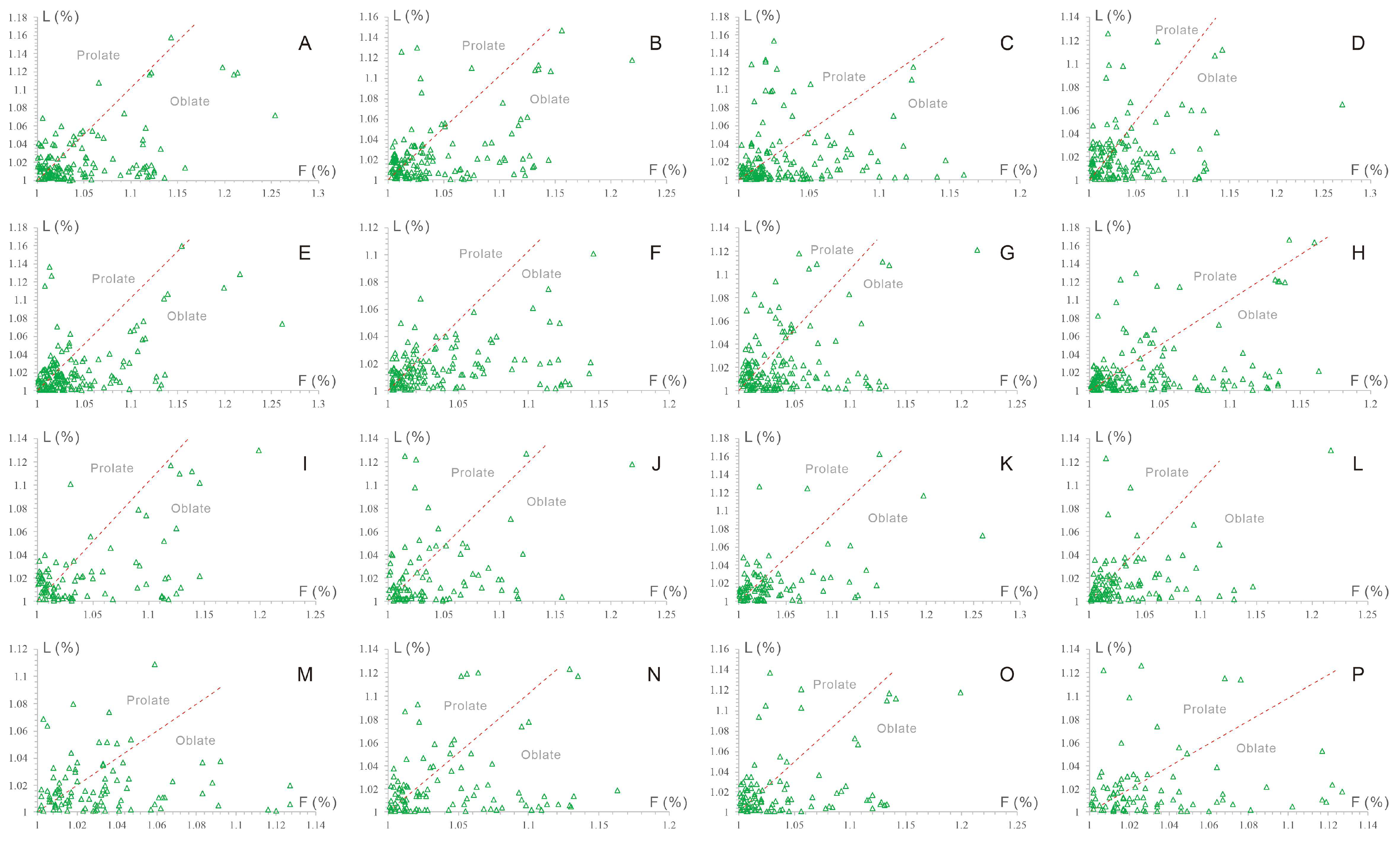


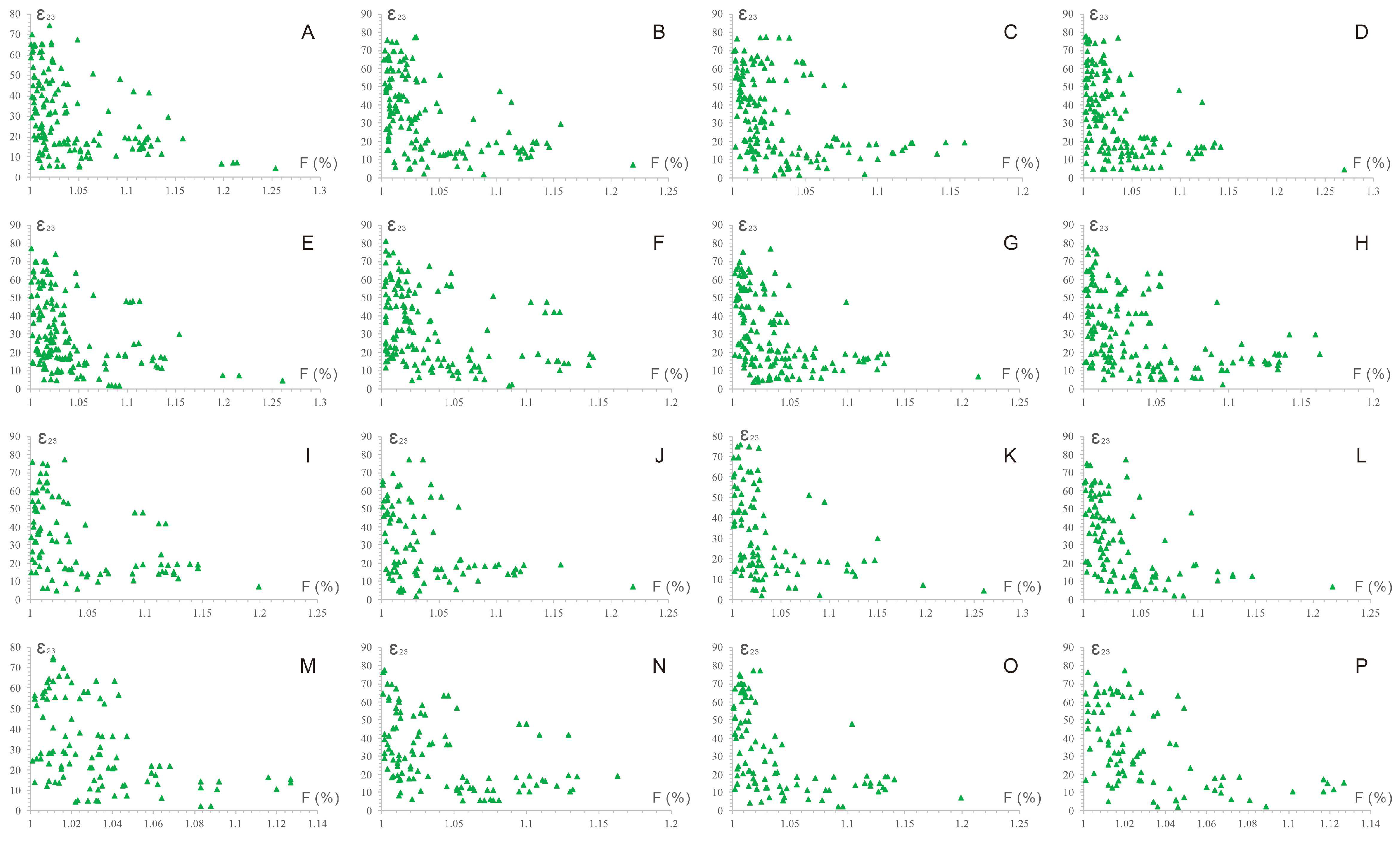

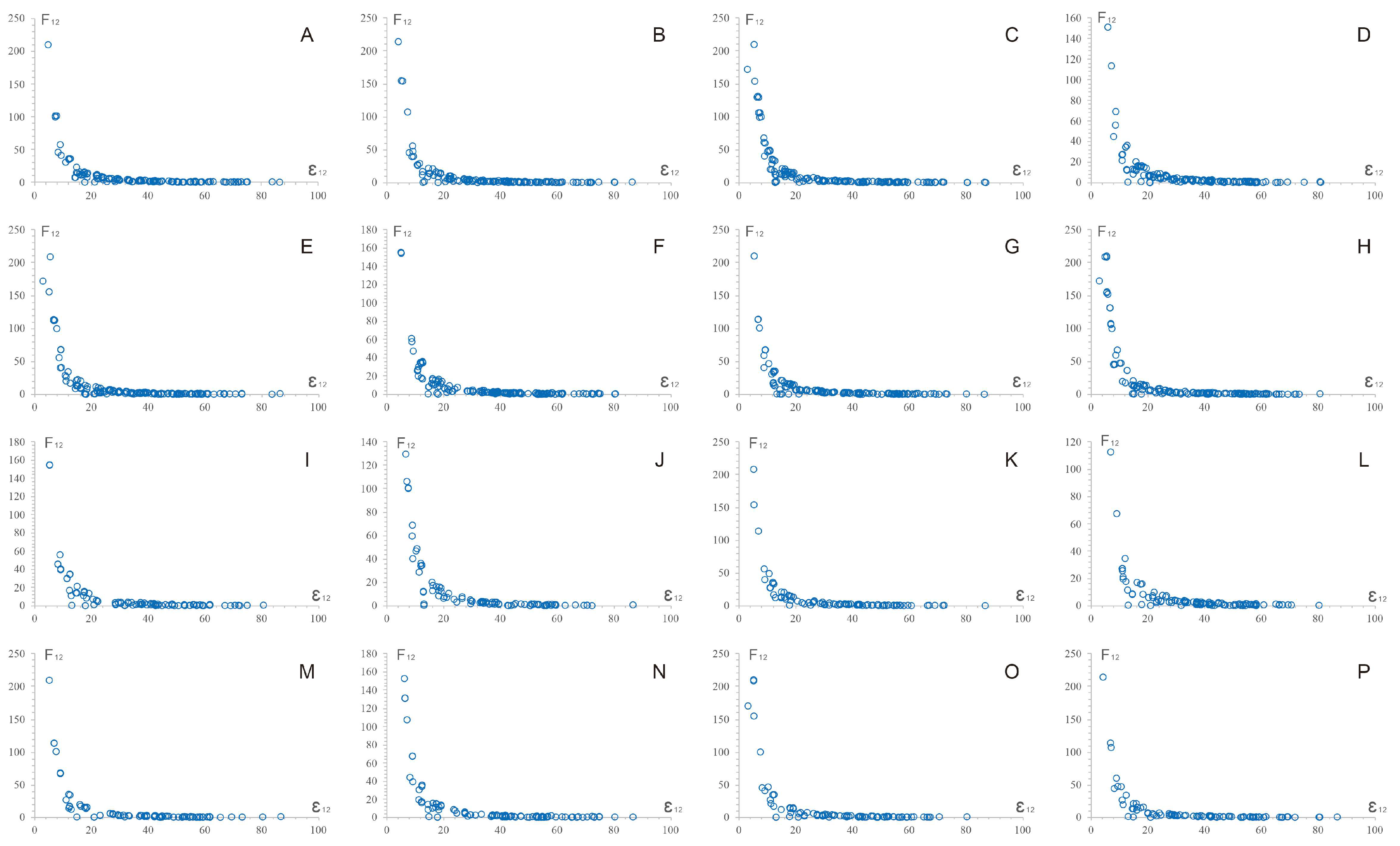

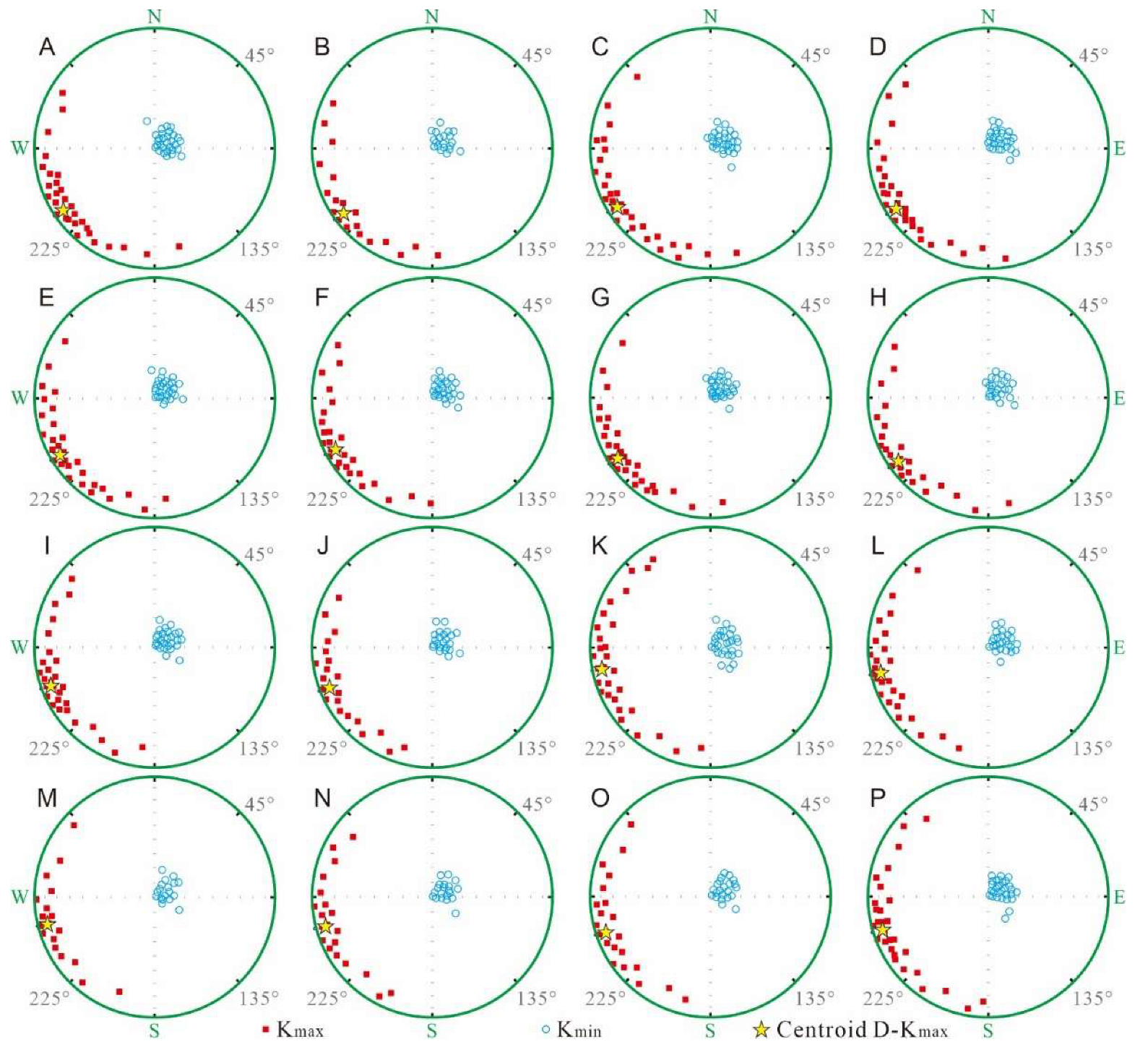

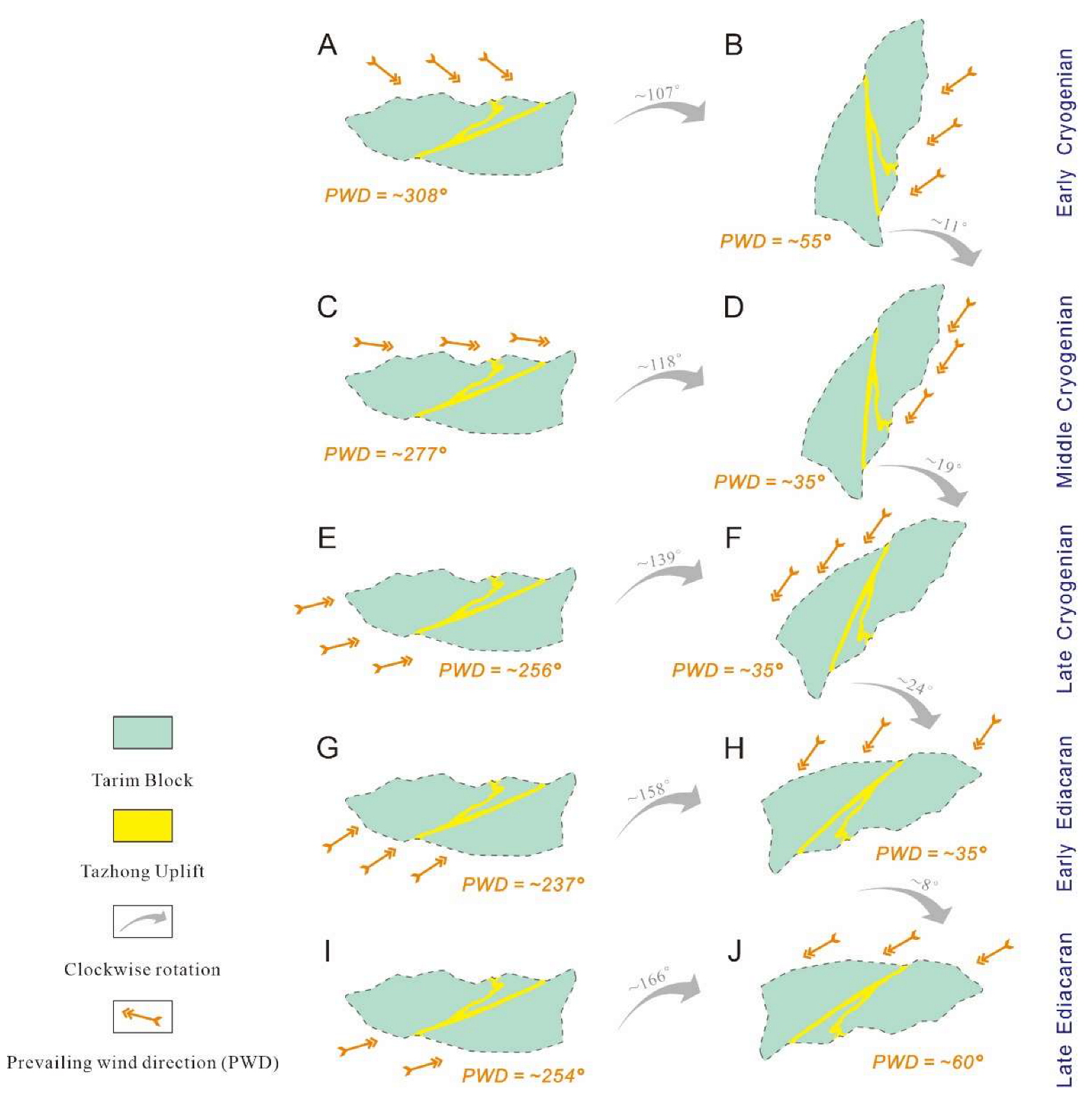
| Outcrop | Lower Cryogenian | Middle Cryogenian | Upper Cryogenian | Lower Ediacaran | Upper Ediacaran |
|---|---|---|---|---|---|
| QK | (24/46) 52% | (31/51) 61% | (20/48) 41% | (30/49) 61% | (28/45) 62% |
| SW | (29/44) 65% | (24/52) 46% | (21/48) 43% | (20/44) 45% | (23/48) 47% |
| TK | (25/49) 51% | (23/55) 41% | (25/54) 46% | (29/46) 62% | (29/52) 55% |
| XG | (30/51) 58% | (29/53) 54% | (26/49) 53% | (29/57) 50% | (26/50) 52% |
| XY | (20/46) 44% | (31/57) 55% | (21/52) 41% | (29/53) 55% | (18/46) 40% |
| XZ | (32/52) 61% | (30/55) 55% | (27/45) 60% | (27/58) 47% | (20/45) 45% |
| YD | (25/52) 49% | (30/56) 53% | (27/46) 59% | (30/52) 58% | (22/45) 48% |
| YM | (24/49) 48% | (30/56) 53% | (31/55) 56% | (24/43) 55% | (29/48) 61% |
| No. | Outcrop | Cryogenian | Ediacaran | |||
|---|---|---|---|---|---|---|
| Lower | Middle | Upper | Lower | Upper | ||
| 1 | QK | 256°–1° (centroid 310°) | 222°–337° (centroid 280°) | 192°–324° (centroid 257°) | 166°–301° (centroid 236°) | 187°–310° (centroid 249°) |
| 2 | SW | 248°–4° (centroid 307°) | 217°–322° (centroid 273°) | 180°–322° (centroid 252°) | 177°–294° (centroid 234°) | 196°–298° (centroid 249°) |
| 3 | TK | 257°–356° (centroid 309°) | 222°–326° (centroid 275°) | 189°–319° (centroid 251°) | 166°–314° (centroid 238°) | 185°–327° (centroid 260°) |
| 4 | XG | 243°–6° (centroid 310°) | 205°–348° (centroid 278°) | 183°–322° (centroid 256°) | 171°–308° (centroid 237°) | 196°–319° (centroid 258°) |
| 5 | XY | 251°–352° (centroid 305°) | 214°–333° (centroid 276°) | 191°–329° (centroid 259°) | 174°–302° (centroid 240°) | 200°–312° (centroid 256°) |
| 6 | XZ | 239°–357° (centroid 303°) | 199°–351° (centroid 273°) | 189°–311° (centroid 253°) | 181°–299° (centroid 242°) | 203°–307° (centroid 255°) |
| 7 | YD | 253°–4° (centroid 311°) | 215°–345°(centroid 283°) | 186°–324° (centroid 258°) | 173°–302° (centroid 237°) | 194°–313° (centroid 250°) |
| 8 | YM | 260°–347° (centroid 307°) | 202°–350° (centroid 279°) | 189°–321° (centroid 261°) | 169°–298° (centroid 235°) | 183°–321° (centroid 252°) |
| Mean | 308° ± 69° | 277° ± 78° | 256° ± 76° | 237° ± 77° | 254° ± 73° | |
| No. | System | Series | Outcrops | D-Kmax | I-Kmax | D-Kint | I-Kint | D-Kmin | I-Kmin | Uncertainty Values of D-Kmax |
|---|---|---|---|---|---|---|---|---|---|---|
| 1 | Ediacaran | Upper | QK, SW, TK, XG, XY, XZ, YD, and YM | 253.6° | 14.3° | 338.5° | 19.4° | 63.1° | 77.4° | ±72.6° |
| 2 | Lower | 237.4° | 15.8° | 320.3° | 13.3° | 56.7° | 73.8° | ±77.3° | ||
| 3 | Cryogenian | Upper | 255.9° | 16.4° | 338.2° | 26.1° | 70.9° | 72.2° | ±75.8° | |
| 4 | Middle | 277.1° | 15.6° | 12.9° | 13.1° | 94.9° | 74.3° | ±77.9° | ||
| 5 | Lower | 307.8° | 13.2° | 34.4° | 21.4° | 130.1° | 78.7° | ±68.7° |
Publisher’s Note: MDPI stays neutral with regard to jurisdictional claims in published maps and institutional affiliations. |
© 2022 by the authors. Licensee MDPI, Basel, Switzerland. This article is an open access article distributed under the terms and conditions of the Creative Commons Attribution (CC BY) license (https://creativecommons.org/licenses/by/4.0/).
Share and Cite
Hu, C.; Han, C.; Ma, J.; Deng, L.; Zhao, L. Paleowind Directions over the Tarim Block during the Mesoproterozoic, Northwestern China. Minerals 2022, 12, 1435. https://doi.org/10.3390/min12111435
Hu C, Han C, Ma J, Deng L, Zhao L. Paleowind Directions over the Tarim Block during the Mesoproterozoic, Northwestern China. Minerals. 2022; 12(11):1435. https://doi.org/10.3390/min12111435
Chicago/Turabian StyleHu, Chenlin, Changcheng Han, Jinghui Ma, Li Deng, and Lingfeng Zhao. 2022. "Paleowind Directions over the Tarim Block during the Mesoproterozoic, Northwestern China" Minerals 12, no. 11: 1435. https://doi.org/10.3390/min12111435
APA StyleHu, C., Han, C., Ma, J., Deng, L., & Zhao, L. (2022). Paleowind Directions over the Tarim Block during the Mesoproterozoic, Northwestern China. Minerals, 12(11), 1435. https://doi.org/10.3390/min12111435






